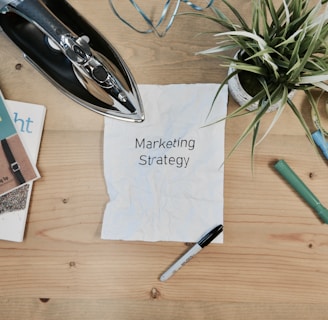Download your FREE Magnetic Magic guide!
Smart Marketing on a Shoestring Budget: How to Grow Without Overspending
Marketing without a budget might feel like cooking without a recipe—but with the right ingredients, it still comes out great.
Pam Seino
5/15/20253 min read


It's not a secret that in order to grow your business, you need marketing. But effective marketing often feels out of reach when you’re running on limited funds. The good news? You don’t need a massive budget to build your brand, reach your audience, or generate sales. With the right tools—and a smart strategy—you can do a lot with a little.
And in today’s world, that includes using AI to save time, increase consistency, and amplify your efforts.
Here’s how to make the most of your marketing budget in 2025.
1. Use Social Media to Build Brand Visibility (for Free)
Social media is one of the most powerful and cost-effective ways to grow your business. But to get results, you need a plan.
Start by identifying your audience. Are they professionals on LinkedIn? Visual learners on Instagram? Or everyday users on Facebook and TikTok? Focus your efforts where they spend time.
Be consistent. A regular posting schedule keeps your brand visible and trustworthy.
Engage actively. Don’t just post—respond to comments, ask questions, and interact with your community.
Tip: Use AI tools like ChatGPT or Jasper to brainstorm post ideas, write captions, and repurpose content. Tools like Canva can also help you create professional-looking graphics even if you’re not a designer.
Hashtag research tools like RiteTag or Flick can help you find trending or niche-specific hashtags to increase reach.
2. Run Budget-Friendly Paid Ads (That Actually Work)
You don’t need thousands of dollars to run ads. Platforms like Facebook, Instagram, and Google offer advertising options that can be effective even on small budgets.
Set a daily or weekly budget and stick to it.
Use targeting features to make sure your ads reach the right people.
Test and optimize—track performance, then adjust based on what works.
Tip: Use AI ad generators like AdCreative.ai to quickly develop ad headlines, images, and descriptions. You can also use ChatGPT to A/B test different versions of your messaging or landing page copy.
3. Make SEO Work for You (So Google Can Send You Traffic)
Search engine optimization (SEO) is one of the best long-term strategies for growing a business organically.
Use relevant keywords naturally in your website copy, blogs, and headlines.
Publish helpful, high-quality content your audience actually wants—how-tos, tips, or answers to common questions.
Improve your site’s speed and mobile performance so people stick around and search engines rank you higher.
Tip: Use tools like Ubersuggest, AnswerThePublic, or ChatGPT to research keywords, brainstorm blog ideas, or write outlines. Then use a free tool like Google PageSpeed Insights to check and improve your site’s performance.
4. Collaborate with Micro-Influencers or Brand Ambassadors
Partnering with the right influencer can give your product instant visibility and social proof. The trick? Look for micro-influencers (those with 1K–10K followers) who align with your niche and have high engagement rates.
Many micro-influencers are open to product exchanges or small fees.
You can also build ambassador programs with loyal customers who promote your brand in exchange for perks or commissions. Get creative, and reap the benefits!
Tip: Use platforms like Collabstr, Influencity, or even AI tools like Heepsy to identify influencers who fit your ideal brand profile and budget.
5. Use AI to Do More with Less
AI is everywhere these days, and it isn’t just a buzzword—it’s a time-saver, creative partner, and research assistant, especially for solopreneurs and small teams.
Here are a few ways AI can streamline your marketing:
Content creation: Tools like ChatGPT, Copy.ai, or Jasper can write social captions, emails, blog posts, and more.
Design support: Platforms like Canva’s Magic Design or Looka can help with visuals, logos, and branding materials.
Market research: Use AI to summarize industry trends, analyze competitors, or generate customer personas.
Important: While AI is supremely helpful and can benefit you in myriad ways, never simply copy and paste AI's output. Not only does it not optimally serve your customers, search engines will know it and your content won't rank. AI is an excellent resource for creating outlines, starting blog articles, and much more, but always proofread the output for accuracy and modify it with your own personal touch and experiences.
Final Thoughts: Be Resourceful, Not Perfect
You don’t need to do everything at once. Start with what you can manage. The key is to be strategic, consistent, and willing to adapt. Marketing success isn’t about how much you spend—it’s about how well you connect with your audience.
Use the tools available to you, stay curious, and lean into AI where it helps you save time or boost quality.
Your budget might be limited, but your growth potential doesn’t have to be.
